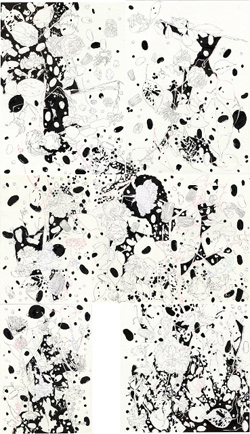 |
 |
Untitled, 2007
Ink on paper, 1 of 7 pieces, 85 x 50 cm
Courtesy of Kodama Gallery, Osaka
|
|
The title of Ryoko Aoki's most recent exhibition, "Under the Secret" at the Kodama Gallery, Osaka, implies that spectators are going to find something out. This is not necessarily the case. One arrives at the back gallery to find a little album placed upon a table, but the cover page title brings the search to an inevitably disappointing conclusion: "Under the secret: keeping secret by drawings and inserts from someone's words." Presumably the words are the artist's, but even this is uncertain. The texts among images often appear to be copied, mirroring the way Aoki traces imagery from visual sources on the plant and animal kingdoms. Beyond this, interpretation becomes devilish, and other key words from within the album provide the essential character of obfuscation at work here: "incommensurable," "pop magic," "pop occult."
If interpretation is devilish, so too is the arrangement. Individual drawings, tracings and texts are stuck up on the wall with tacks, and the entire area becomes a tortuously convoluted sprawl of spatial and relational incoherence. There is also a strong quality of "refuse" to the tangled, organic thrust of the layout. There are squares of crumpled card, the scrappy margin of a note page torn from its binding in "Sukima" (2007), or the little green lawn and flower design made from the decorative green plastic sheeting of supermarket sushi packaging that forms part of "The Complete Gardener" (2007).
Even deciding what constitutes a particular work is in question. Titles are often entirely absent or on little caption notes placed sporadically such that they become all but invisible among the massed detritus. The three pieces that apparently form "Oshogatsu" (2007), for example, show a carefully traced horse's head, a woman with long hair, and an oblong piece of card from which symmetrical shapes have been cut away. But these three pieces, bordered as they are by a vast array of divergent imagery, never seem to cohere as a single work stylistically, formally or relationally.
Beyond this, post-it notes have been stuck to the wall beneath the rose and foliage design of "Hanuke" (2007) as if the overall scheme were still under consideration, or yet to be thought through. The prominent characteristic is confusion, and as might be expected, media and modes do not escape this. One finds figuration, abstraction, geometry, organicism, felt-pen, pencil, ink, fabric, mosaic designs of shiny and matte card, plastic, fabric, and imagery ranging from Surrealist-inspired morphing to roses (an Aoki favorite) and a scribbled "Angry Santa Claus" (2007).
Inasmuch as Aoki's works are full of frames and narrative moments, written and visual, they lack a wider frame of reference, and so a grounding context is indefinitely deferred, or conceivably absent. In that sense her work is fundamentally inenarrable -- incapable of being narrated. In one section we are treated to a dry transcription of "Sources of Light" (2007) discussing artificial lighting, and then the text moves on to explicate long-flowering exotics, annuals and perennials that require good drainage. Nearby a vortex-like swirling abstract design is captioned "So long ago you can't even conceive" (2007).
A central desire is to make connections between these nonsensical parts, but lacunae keep cropping up, making it impossible to tell exactly what is happening in the work, or to discern in what manner the parts might go together. More plausibly they do not, and viewers are left to move back and forth over imagery and text, skip a section here and there, and tolerate the lack of coherence as the point of the work. The result is frustration, akin to that of not being let in on a secret when we were expecting to be.
A visual clue to the character of the exhibition can be found in "Tissue Flower" (2007). The simple drawing in outline is of a crumpled tissue and a straw whose figurative combination forms a passable representation of a flower with stalk. At another level, however, the representation falls back apart into its constituent elements of tissue and straw, and then to the line work, which is not treated in any particular detail or given fuller form. In two other untitled portraits a similar concern emerges. The artifice of the mark-making which would ordinarily congeal to give a picture of the sitter dissolves in such a way that it is difficult to see the image of the person rather than the mark-making itself, and so the figuration keeps falling apart into individual squiggles, unable to cohere.
The idea, ostensibly, is that the discrete parts will not yield a clear image, or that an assemblage of overwrought fragments will not "add up".
|
|
Kikkin, 2007
Ink, felt-tip pen on paper, 29.6 x 21 cm
Courtesy of Kodama Gallery, Osaka
|
|